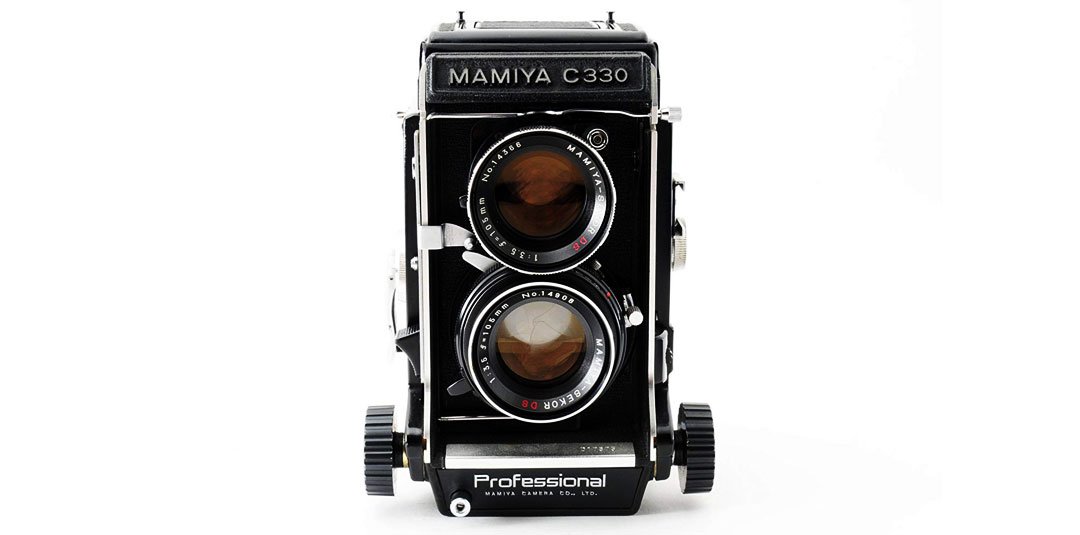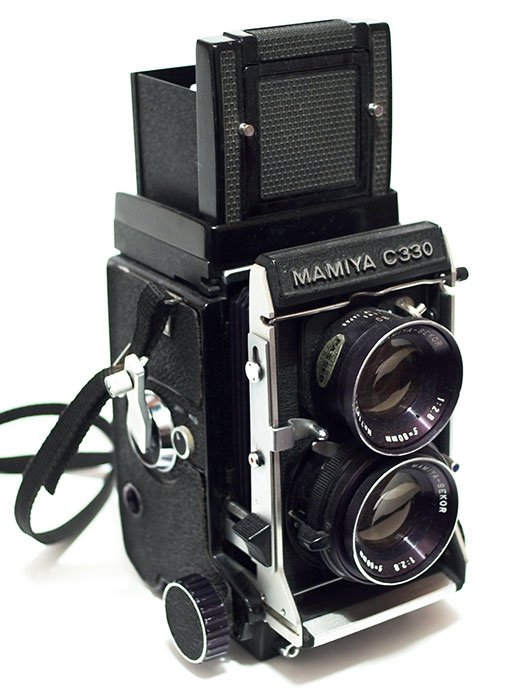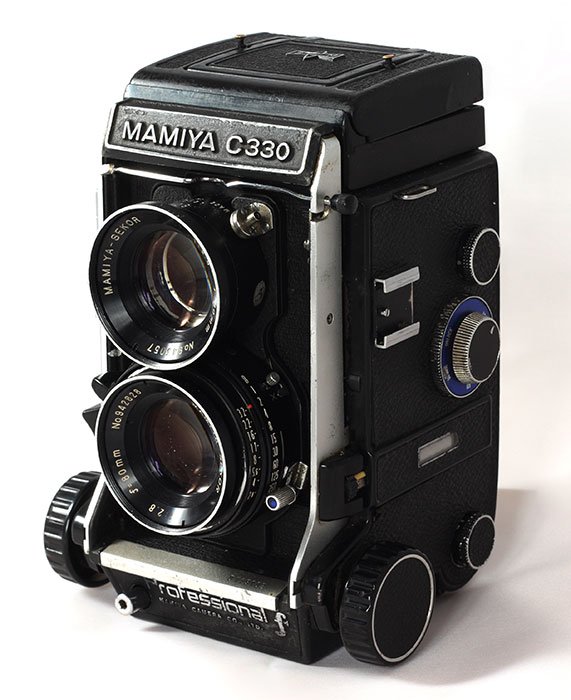The Mamiya 330 – A TLR Legend
The Rolleiflex 2.8f vs Mamiya C330F? Most would give the TLR “legend” status to the Rolleiflex 2.8. And I primarily agree. But comparing the images, the build, the price point and the extensive lens availability, and the Mamiya C330 will actually more than hold it’s own in a head to head competition. (not to mention the earlier Mamiya C220) But this is NOT a comparison. Just a casual look at the Mamiya C330F “tank”‘ TLR’s are not a “new” thing, favored by Diane Arbus, Vivian Maier and many others. Although usually in the form of Rolleiflexes.
Of course, I wanted a Hasselblad, or even a Rollei TLR would do. But alas, I was in college and broke. So, I narrowed my choices down to a Mamiya C220, Yashica Mat or Mamiya C330. As luck would have it, a friend was selling his and let me have it for $150. About the same as a Yashica Mat 124G at the local pawn shop. Also, this was an “F”. The only important thing I would look for is the 80mm lens being a multicoated model. (Mamiya-Sekor 80mm f/2.8 “Blue Dot” lens) Other than that, just some minor differences in how much plastic was used between the F vs S models. (the newer 330S uses more plastic, but is a little lighter) They are all about the same camera. Do I think the ‘F’ was better? Nah.
Cock My Shutter,…Please
I didn’t know much in those days, but I did know enough that I didn’t want a C220. Although pretty close to each other in design, I knew I needed a camera that cocked the shutter automatically on film advance. On the C220, the shutter has to be cocked separately. Due to my absent mindedness, I knew that wouldn’t be the camera for me. Besides,…the C330 looked cooler.
While I wasn’t going to get my dream TLR, (Rolleiflex), with their super sharp Zeiss Planar or Schneider Xenar lenses, the Mamiya ended up being razor sharp from f/4 and beyond. And the larger than 35mm negative was an epiphany in the darkroom. The images above were my first adventure with the Mamiya C330 TLR and some tungsten floodlights and daylight.
The original model was just called a Mamiyaflex C. It was released in 1957. I’ve personally never seen one. When they started tweaking this camera, they broke off into two models; the C2 and the C3. While I may have been able to afford a Rolleicord, (as opposed to a Rolleiflex), the Mamiya C330 actually had more features. Including interchangeable focus screens and ability to use both 120 and 220 film.
Seven Lenses
While I only used the 80mm lens, (I almost always use “normal” focal lengths on all cameras), the ability to choose a wide array of interchangable lenses was a big plus. They made 7 lenses for this camera! 55 mm f/4.5, 65 mm f/3.5, 80 mm f/2.8,105 mm f/3.5,135 mm f/4.5,180 mm f/4.5 and 250 mm f/6.3 . Good Lord! Talk about commitment to a platform, Mamiya was definitely in for the long haul.
Another nice feature was the parallax correction dial for close-ups. Switching lenses was a two part procedure. Put the “lens lock” dial in the unlock position, and then move the bar holding the lens onto the camera. I know,….sounds tedious. It’s not. And when you switch to unlock mode, it flips a protective shield in front of the film plane! You can change lenses in mid-roll. Very cool.
While it’s a bit bigger and heavier than other cameras of the TLR variety, it’s built very solid. You will know that on first use. One thing it does have in common with a Rolleiflex; this is a very beautiful camera. I would actually put it by my bedside to see it on first waking in the morning. However, I’m a little cracked. Or so I’ve been told.
Mamiya 330 TLR and Bellows
The flexible bellows of the Mamiya C330 TLR is like a built in macro tube. You can, if carefully used, and minding the parallax indicator, get within about 5 inches. I say ‘about’ because I’ve never measured it. And, of course, with the 55mm lens, probably about 3 inches. Anyway, very, very close. But the closer you get to your subject the bigger the difference in what image taking lens sees. Remember, this is not an SLR. However, there are no issues at normal distances and beyond.
While the camera does have a built in parallax correction tool, it is prone to error if you get too close. In fact, if macro photography is your thing, I’d stick to an SLR. Even rangefinder cameras are less than ideal. I won’t explain the whole messing with parallax correction dials and the indicator, etc. Suffice it to say, if you’re taking a normal photograph from a normal distance, you will never have a problem. If you mostly must be within inches of your subject,…TLR’s are not for you. Any TLR. Helmut Newton mostly used a Rollei TLR in the early part of his career. Vivian Maier and Diane Arbus almost exclusively. So, if those are the types of work you are doing, the Mamiya C330 TLR is a highly recommended tank.
No Mirror Slap
One thing both rangefinders and TLR’s have over SLR’s. No mirror slap. If you love shooting at very low shutter speeds, that is a very big deal. As far as syncing to flash, the Mamiya C330 TLR syncs at all speeds. The fully mechanical shutters are in the lenses, not the camera body. The shutter speeds range from 1 second to 1/500 sec. Plus Bulb. (indefinite shutter)

While the standard viewfinder and split screen are sharp and bright, even outside, replacement screens are available. In fact, a “Sports Finder” is available for those who dislike waist level finders. One is 90 degree (shown) and one is looking straight down. But if you’re looking for auto exposure, matrix metering, fuzzy logic, or the old “digital” shoot and pray modes, you won’t find them here. Do yourself a favor and move on. But if you like the 6×6 format, love 120/220 film and want a solid camera that will last 2 lifetimes,….you’ve come to the right place. Find a Mamiya C220 or Mamiya C330 or Mamiya C33





I’ve got 2 and a rb 67 love em
I’ve just got my C220 and C330 out to check the seals. I also had a Yashicamat 124G which now regret selling long ago. All these Japanese 120 cameras are capable of stunning results and I’ve fond memories of using them back in the day.
Hi Mark,
Yes, they are awesome cameras that in some ways are even better than the TLR Rolleiflexes. Seals should be changed every 10 years anyway. Plus, Mamiya C seals are cheap. https://uscamera.com/product/mamiya-c-series-light-seals/
Regards
Federico
Hi,
Nice review! I used a lot C33 many years ago. It was a great camera. A couple of years ago I tried C330f. But I still prefer C33 model.
What about the c220f vs c330f ?
Hi Tasos,
The C330 cocks the shutters on the lenses when the film is advanced and the C220 doesn’t. And while the C220 is lighter, the C330 is more of a tank in the most professional sense. (and looks cooler) Plus the C330 also has 2 shutter releases, one of which directly interfaces with a Mamiya grip. The C330 also has automatic parallex compensation, which is useful for closer subjects. The C220 is slightly lighter, but not enough to make me want to separately cock a shutter. Image wise? Same. The main difference between the C330 and C330F is a focus lock lever. And the C330S has a much brighter screen. But, you can change the screen on all of them. Plus some have more plastic and some less. But, they’re all great cameras and lenses, including the older C33. Some stuff you just don’t need. Like I don’t think you can change the screens on a C33, but you can on a C330. Thought to be the cat’s meow at the time. (60’s?) But if you’re just concerned with the image, they’re all good and all beyond any modern camera builds.
My 2 cents.